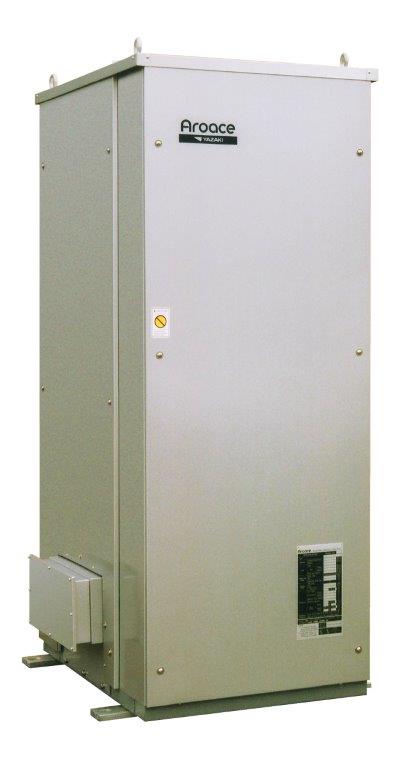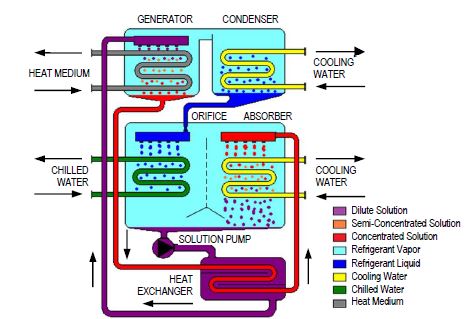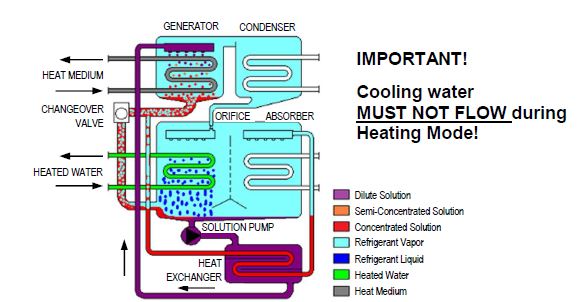

Water Fired Single-Effect Chillers and Chiller-Heaters
How They Work
The water-fired thermal chiller offers a cutting-edge solution for businesses looking to optimize energy efficiency. With advanced capabilities for fuel switching, cogeneration, and waste heat recovery, this system helps achieve carbon neutral cooling. Ideal for industrial applications, the water-fired chiller is a non-electric, low-noise alternative to traditional electric chillers.
- Water Fired SINGLE-EFFECT Chiller or Chiller-heater
- Yazaki water-fired SINGLE-EFFECT chillers (with cooling capacities of 5 to 100 tons of refrigeration) produce chilled water for cooling, while chiller-heaters (with cooling capacities of 10 to 30 tons of refrigeration) produce chilled water, but also can provide hot water for heating in comfort air conditioning applications. The absorption cycle is energized by a heat medium (hot water) ranging from 158°F to 203°F from an industrial process, cogeneration system, solar energy, or other heat source. The condenser circuit is water cooled through a cooling tower or ground loop.
- Absorption Principle
- Yazaki absorption chiller-heaters use a solution of lithium bromide and water, under a vacuum as the working fluid. Water is the refrigerant and lithium bromide (a non-toxic salt) is the absorbent. Refrigerant, liberated by heat from the solution, produces a refrigerating effect in the evaporator when cooling water is circulated through the condenser and absorber.
- Cooling Cycle

- Generator
When the heat medium inlet temperature exceeds 154.4°F, the solution pump forces dilute solution into the generator. The solution boils on the surface of the generator tubing bundle, releasing refrigerant vapor which rises up and flows over into the condenser. As a result the solution becomes more concentrated and it drops into the generator sump, where it drains down through a heat exchanger before entering the absorber section.
- Condenser
Refrigerant vapor is condensed on the surface of the condenser coil and latent heat, removed by the cooling water, is rejected to a cooling tower or ground loop. Refrigerant liquid accumulates in the condenser sump and then passes through an orifice into the evaporator.
- Evaporator
In the evaporator the refrigerant liquid is exposed to a substantially deeper vacuum than in the condenser due to the influence of the absorber. As the refrigerant liquid flows over the surface of the evaporator coil, it boils into vapor and removes an amount of heat from the chilled water circuit equivalent to the latent heat of the refrigerant. The recirculating chilled water is cooled to the selected set point and the refrigerant vapor is attracted to the absorber.
- Absorber
A deep vacuum in the absorber is maintained by the affinity of the concentrated solution from the generator for the refrigerant vapor formed in the evaporator. The refrigerant vapor is absorbed by the concentrated lithium bromide solution flowing across the surface of the absorber coil. Heat of condensation and dilution is removed by the cooling water and rejected to a cooling tower. The resulting dilute solution is preheated in a heat exchanger and returned to the generator where the cycle is repeated.
- Heating Cycle

- Generator
When the heat medium inlet temperature exceeds 154.4°F, the solution pump forces dilute solution into the generator tubing bundle. The solution boils on the surface of the generator, releasing refrigerant vapor, which rises and flows into the condenser. The solution becomes more concentrated as a result and the concentrated solution drops into the generator sump where it drains down through a heat exchanger before entering the absorber section.
- Evaporator
Hot refrigerant vapor condenses on the surface of the evaporator coil and an amount of heat equivalent to the latent heat of the refrigerant is transferred into the hot water circuit. The recirculating water is heated to the selected set point. Refrigerant liquid mixes with concentrated solution and the resulting dilute solution returns to the generator where the cycle is repeated.